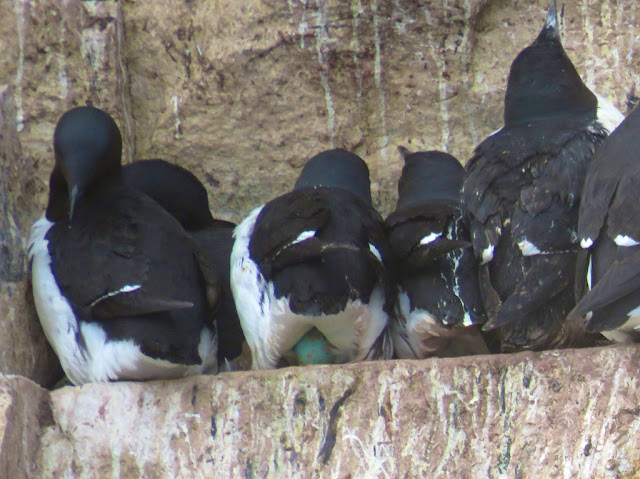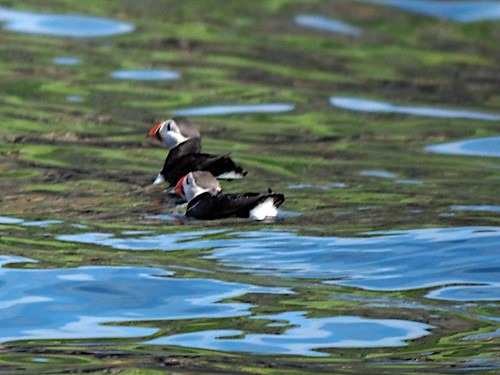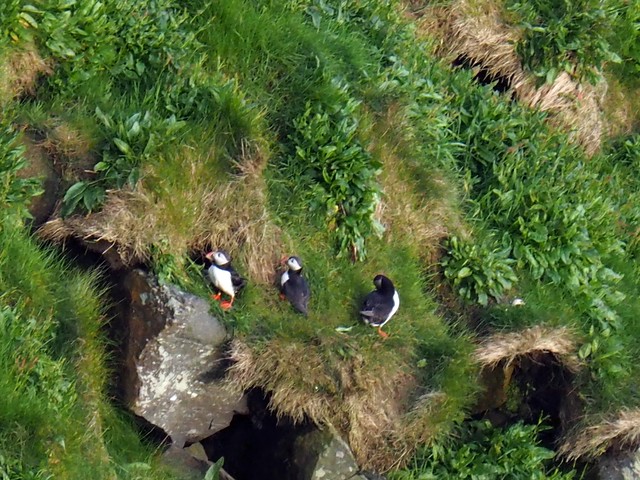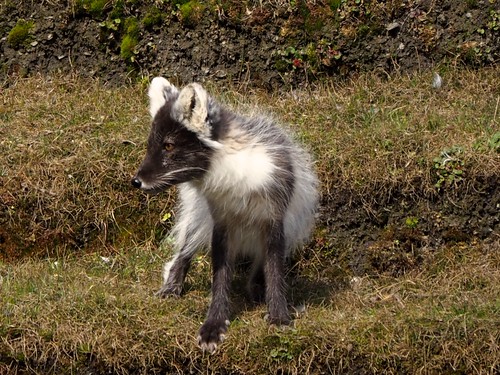The vast numbers of birds in Arctic nesting colonies is overwhelming. Hiking at various places in Svalbard we saw a colony of kittiwakes, as shown above, and also a colony of dovekies (little auks). One morning on the ship, we approached a colony of Brunnich's guillemots (thick-billed murres). On the island of Runde, where we visited before our cruise, we saw two colonies: puffins and gannets.
 |
| Gannet colony at Runde. |
As we approached each colony, whether by hiking or by sea, we first heard the racket of bird calls and saw the swirling flights of hundreds of birds. As we came closer, we could see the thousands of nests and roosting sites in niches or holes in the cliffs and observe a variety of activities in the colony. With binoculars we could view individuals a few at a time. So many birds!
 |
| Dovekies Flying |
It was foggy as we approached huge cliffs where guillemots nest. We could see birds swimming and wheeling over the water, and slowly could see numerous ledges crowded with birds. The ship approached amazingly close to the sheer face of the cliff looming over us.
 |
| Guillemot colony on Svalbard. |
 |
| Guillemots on the ledge -- streaks of droppings below. Note the egg under the bird just left of center. |
Bird nesting colonies are all about food. Most of them are on rocky cliffs with no vegetation or other sources of nutrition for the birds and their chicks. Adult birds fly out to sea to catch fish or find other marine sources of food, returning to their rocky shelves or holes in the ground to lay eggs, keep them warm, and eventually to feed the hungry youngsters.
 |
| Puffins swimming in the sea near the colony at Runde. They dive down for fish. |
 |
| Three puffins at the Runde colony. The birds fly back from the sea and sit near their holes each evening.
At around 11 PM the puffins go inside. If you want to see them you walk over the mountain top at 8:30.
Runde is not in the Arctic, so the vegetation is much more lush and grassy than in Svalbard. |
 |
| Kittiwake colony on Svalbard -- tens of thousands of birds. |
Predators stalk the birds; thus the marine nutrition can reach members of other species. We saw male birds get into fights over mates, grabbing each other jealously. When the fighting birds spiral down to the rocks, opportunistic glaucous gulls, jaegers, skuas, or foxes are often waiting to grab them. Some younger individuals are not yet ready to nest, but they hang around the colony with the mated pairs. I've already posted a photo of a gull eating a guillemot from the colony we saw.
 |
| An arctic fox waiting below the kittiwake colony. |
 |
| A glaucous gull waiting for these guillemots to make a mistake. |
Our trip was early in the nesting season; birds were just pairing up or sitting on eggs. Once they hatch, the chicks will be even more vulnerable, and no doubt provide a very attractive source of food for the predators. To avoid predators, chicks leave the nesting areas when they are quite small, pushed down to swim in the safer sea by their parents.
 |
| One dovekie in the colony. Note how green the moss is! |
As I said in my post about the tundra, moss and grasses below a nesting colony are visibly much greener and more lush than the areas that don't receive nitrogen-rich bird droppings from above. These green areas attract other birds and also reindeer to eat the especially nutritious lichens, so the fish eaten by the nesting birds ultimately feed other species as well.




















































